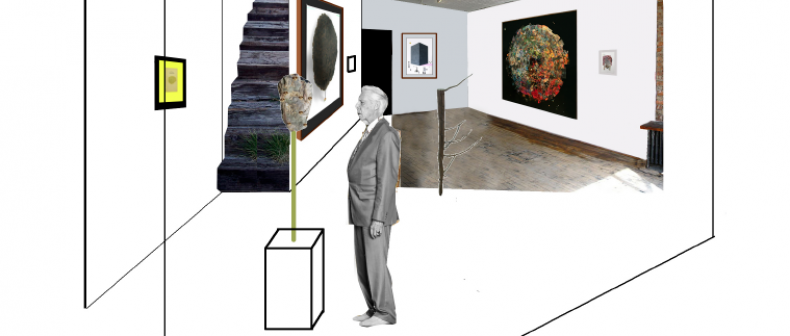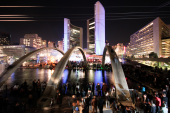
Credit: Clint Roenisch Gallery
To the casual observer, “Year Zero,” Jason de Haan’s sophomore show at Clint Roenisch Gallery might seem like the kind of thing produced by someone who wears a bicycle helmet indoors, has manually removed their dental fillings and covers their windows in tin foil. The show is replete with planets and satellites of various kinds — floating chunks of alabaster, two massive collaged globes, a pendulous orb of melted coins (more about all of these later) — to say nothing of the other works: sci-fi illustrations layered atop or juxtaposed against Classical statuary, perpetually reiterated references to suns and moons, cyanotype prints made during partial lunar eclipses, drawings made from Iridium, a branch of petrified wood inset with a gold ring. Planets, elements, minerals, arcane rituals: the fever dream of a science fiction fanatic.
Anyone who spends time with “Year Zero” — and the show has everything to do with time — will realize that De Haan is not frantically watching the skies for portents and omens. Quite the opposite: there is a stately augustness to “Year Zero,” a grounding, meditative calm.
This is nothing new for de Haan. This kind of mystical geology has been an obsession for a long time — his Salt Beards, for instance (in which mineral deposits attached to found sculptural busts perpetuate themselves, in effect growing ghostly pearlescent “beards”) date back to 2009. The elemental mysteries of the Earth are an ambitious artistic obsession to begin with, and in “Year Zero,” the breadth of de Haan’s reach is much more expansive. Here, as with his other work, de Haan is of this earth: contemplating its totality, exploring in his art not only its internal totality — soils, minerals, wood — but its external totality as well, its position in and relationship to the cosmos.
There are several knockouts in this show – two wall-sized collaged planets come to mind. One is a heaving globe of flatly coloured scraps that runs the chromatic spectrum from saturated indigo to a solar yellow, another a gleaming futuristic pile-on of cutouts from pulp science fiction covers, every inch covered in metal and glass towers or flying cars. In that pairing, de Haan flattens an entire cosmological timeline to its two endpoints: the undulating gaseous mass of a planet’s conception (I am reminded of the Hebrew word for the formless chaos at the dawn of time — for which there is no proper English translation — to’hu va vo’hu), and its glitzy future, overpopulated, every inch colonized and occupied. Each planet is a teeming bulk of layered fragments; they might take different outward forms, but chaos is chaos, whether at the beginning or at the end.
The star attraction of the rear gallery is the aforementioned sphere, cast from a coin from each of the world’s active currencies. There are other highlights that aren’t quite as bombastic. The cyanotype, for instance: the gallery’s handout explains that it was made by exposing a coin on specially treated paper during a partial lunar eclipse. Fair enough, but that pedestrian account of its genesis by no means accounts for its profound beauty: that rich carpet of blue (punctuated by a single pale orb) is hypnotic, a chroma that is at once a mottled surface and an infinitely deep space.
It’s a credit to de Haan’s sense of aesthetics that all this cosmological and geological musing is so captivating. But there is something more, something deeper, beyond all of this mineral arcana, galactic narrative and space-age ritual. De Haan’s geological preoccupations sustain his work well enough, but they point to a more personal musing.
There is a kind of elemental spirituality in de Haan’s work, which shouldn’t come as a surprise to anyone: the artistic impulse is simply the religious impulse wearing a different hat. And so, by extension, perhaps his obsession with time on the cosmic scale is a deliberation on time on the artistic scale. Artists have long been trained to be in the business of novelty, of contemporaneity, to be that futuristic planet forever on the cutting edge. With his great chunks of alabaster and branches of petrified wood, with his drawings made of the Earth’s inner crust, currencies melted down to a formless blob (a babel of monetary value), de Haan is turning his back on that impossible ambition. He’s not being atavistic. Instead of attempting to create some new language, de Haan has found his own vocabulary by slowing down, by meditating on the long continuum of art; he is collapsing artistic time into a perpetual creative moment. After all, no matter what the media or technological advancement, artistic materials are made of the same things that cavemen daubed onto the walls of Lascaux: ground up elements and minerals; rocks and metals and clays reshaped in the vision of the artist.
—
Jason de Haan’s “Year Zero” at Clint Roenisch Gallery runs until April 21.
For more, follow us on Twitter at @torontostandard, and subscribe to our newsletter.














